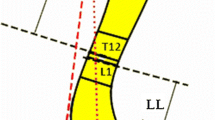Abstract
Purpose
To analyze changes in sagittal spinopelvic parameters (SSPs) after surgical treatment of Scheuermann’s Kyphosis (SK).
Methods
We analyzed 20 patients affected by SK and subjected to posterior correction of the kyphosis by facetectomy, Ponte osteotomy, fusion and multilevel instrumentation with pedicle screw system. Four spinal and three pelvic parameters were measured: sagittal vertical axis (SVA), thoracic kyphosis (TK), thoracolumbar kyphosis, lumbar lordosis (LL), pelvic incidence (PI), sacral slope (SS) and pelvic tilt (PT). Analysis of changes in postprocedural SSPs compared to preoperative values was performed.
Results
TK passed from 78.6° preoperatively to 45.8° (p = 0.003). LL passed from 74.5° preoperatively to 53.5° (p = 0.01). No significant changes occurred in SVA, SS, PT and PI compared to preoperative values.
Conclusion
We confirm the positive effect of surgery by Ponte osteotomy and posterior spinal fusion on TK and LL in patients with SK. In our experience, pelvic parameters did not change after surgery.


Similar content being viewed by others
References
Lowe TG (1990) Scheuermann disease. J Bone Jt Surg Am 72:940–945
Hosman AJ, Langeloo DD, de Kleuver M et al (2002) Analysis of the sagittal plane after surgical management for Scheuermann’s disease: a view on overcorrection and the use of an anterior release. Spine 27:167–175
Scheuermann H (1920) Kyphosis dorsalis juvenilis. 82:385
Damborg F, Engell V, Andersen M et al (2006) Prevalence, concordance, and heritability of Scheuermann kyphosis based on a study of twins. J Bone Jt Surg 88:2133–2136
McKenzie L, Sillence D (1992) Familial Scheuermann disease: a genetic and linkage study. J Med Genet 29:41–45
Lamartina C (2010) Posterior surgery in Scheuermann’s kyphosis. Eur Spine J Off Publ Eur Spine Soc Eur Spinal Deform Soc Eur Sect Cerv Spine Res Soc 19:515–516
Faldini C, Di Martino A, Perna F et al (2014) Changes in spino-pelvic alignment after surgical treatment of high-grade isthmic spondylolisthesis by a posterior approach: a report of 41 cases. Eur Spine J 23:714–719
Mohanty SP, Bhat SN, Ishwara-Keerthi C (2011) The effect of posterior instrumentation of the spine on canal dimensions and neurological recovery in thoracolumbar and lumbar burst fractures. Musculoskelet Surg 95:101–106. doi:10.1007/s12306-011-0111-1
Rawall S, Mohan K, Nene A (2013) Posterior approach in thoracolumbar tuberculosis: a clinical and radiological review of 67 operated cases. Musculoskelet Surg 97:67–75. doi:10.1007/s12306-012-0235-y
Erfani MA, Pourabbas B, Nouraie H et al (2014) Results of fusion and instrumentation of thoracic and lumbar vertebral fractures in children: a prospective ten-year study. Musculoskelet Surg 98:107–114. doi:10.1007/s12306-014-0313-4
Lee J-H, Na K-H, Kim J-H et al (2015) Is pelvic incidence a constant, as everyone knows? Changes of pelvic incidence in surgically corrected adult sagittal deformity. Eur Spine J. doi:10.1007/s00586-015-4199-0
Roussouly P, Pinheiro-Franco JL (2011) Biomechanical analysis of the spino-pelvic organization and adaptation in pathology. Eur Spine J 20:609–618. doi:10.1007/s00586-011-1928-x
Weng W-J, Wang W-J, Wu M-D et al (2015) Characteristics of sagittal spine-pelvis-leg alignment in patients with severe hip osteoarthritis. Eur Spine J Off Publ Eur Spine Soc Eur Spinal Deform Soc Eur Sect Cerv Spine Res Soc 24:1228–1236. doi:10.1007/s00586-014-3700-5
Lamartina C, Berjano P (2014) Classification of sagittal imbalance based on spinal alignment and compensatory mechanisms. Eur Spine J Off Publ Eur Spine Soc Eur Spinal Deform Soc Eur Sect Cerv Spine Res Soc 23:1177–1189. doi:10.1007/s00586-014-3227-9
Sørensen KH (1964) Scheuermann’s juvenile kyphosis: clinical appearances, radiography, aetiology, and prognosis. Munksgaard
Cil A, Yazici M, Uzumcugil A et al (2005) The evolution of sagittal segmental alignment of the spine during childhood. Spine 30:93–100
Papagelopoulos PJ, Mavrogenis AF, Savvidou OD et al (2008) Current concepts in Scheuermann’s kyphosis. Orthopedics 31:52–58. doi:10.3928/01477447-20080101-33
Ashraf A, Noelle Larson A, Polly DW et al (2014) Change in Sagittal plane alignment following surgery for Scheuermann’s Kyphosis. Spine Deform 2:404–409. doi:10.1016/j.jspd.2014.04.013
Behrbalk E, Uri O, Parks RM et al (2014) Posterior-only correction of Scheuermann kyphosis using pedicle screws: economical optimization through screw density reduction. Eur Spine J Off Publ Eur Spine Soc Eur Spinal Deform Soc Eur Sect Cerv Spine Res Soc 23:2203–2210. doi:10.1007/s00586-014-3472-y
Macagno AE, O’Brien MF (2006) Thoracic and thoracolumbar kyphosis in adults. Spine 31:S161–S170. doi:10.1097/01.brs.0000236909.26123.f8
Geck MJ, Macagno A, Ponte A, Shufflebarger HL (2007) The Ponte procedure: posterior only treatment of Scheuermann’s kyphosis using segmental posterior shortening and pedicle screw instrumentation. J Spinal Disord Tech 20:586–593. doi:10.1097/BSD.0b013e31803d3b16
Ponte A (2003) Posterior column shortening for Scheuermann’s kyphosis: an innovative one-stage technique. Surg Tech Spine N Y NY Thieme Med 107–113
Lonner BS, Newton P, Betz R et al (2007) Operative management of Scheuermann’s kyphosis in 78 patients: radiographic outcomes, complications, and technique. Spine 32:2644–2652. doi:10.1097/BRS.0b013e31815a5238
Jiang L, Qiu Y, Xu L et al (2014) Sagittal spinopelvic alignment in adolescents associated with Scheuermann’s kyphosis: a comparison with normal population. Eur Spine J Off Publ Eur Spine Soc Eur Spinal Deform Soc Eur Sect Cerv Spine Res Soc 23:1420–1426. doi:10.1007/s00586-014-3266-2
Tyrakowski M, Mardjetko S, Siemionow K (2014) Radiographic spinopelvic parameters in skeletally mature patients with Scheuermann disease. Spine 39:E1080–E1085. doi:10.1097/BRS.0000000000000460
Author information
Authors and Affiliations
Corresponding author
Ethics declarations
Conflict of interest
None.
Rights and permissions
About this article
Cite this article
Faldini, C., Traina, F., Perna, F. et al. Does surgery for Scheuermann kyphosis influence sagittal spinopelvic parameters?. Eur Spine J 24 (Suppl 7), 893–897 (2015). https://doi.org/10.1007/s00586-015-4253-y
Received:
Revised:
Accepted:
Published:
Issue Date:
DOI: https://doi.org/10.1007/s00586-015-4253-y




